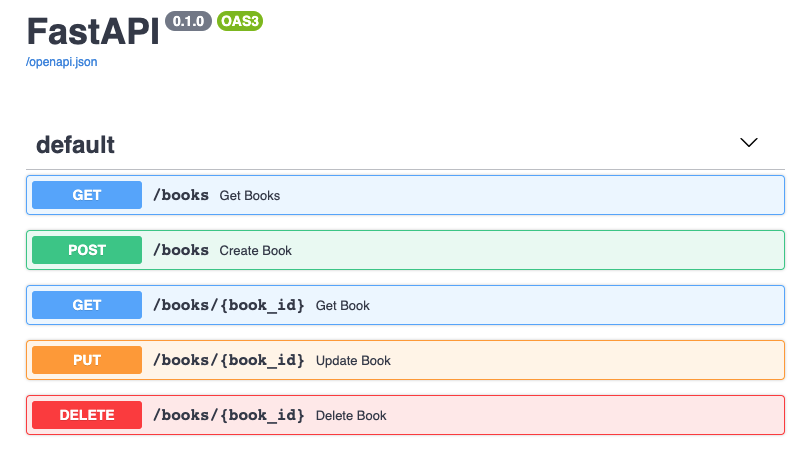English | 日本語
NOTE: This repository is an example to demonstrate "how to implement DDD architecture in a Python web application." If you use this as a reference, ensure to implement authentication and security before deploying it to a real-world environment!
- My blog post: https://iktakahiro.dev/python-ddd-onion-architecture
The directory structure is based on Onion Architecture:
├── main.py
├── dddpy
│ ├── domain
│ │ └── book
│ ├── infrastructure
│ │ └── sqlite
│ │ ├── book
│ │ └── database.py
│ ├── presentation
│ │ └── schema
│ │ └── book
│ └── usecase
│ └── book
└── tests
To represent an Entity in Python, use the __eq__() method to ensure the object's identity.
class Book:
def __init__(self, id: str, title: str):
self.id: str = id
self.title: str = title
def __eq__(self, o: object) -> bool:
if isinstance(o, Book):
return self.id == o.id
return FalseTo represent a Value Object, use the @dataclass decorator with eq=True and frozen=True.
The following code implements a book's ISBN code as a Value Object.
@dataclass(init=False, eq=True, frozen=True)
class Isbn:
value: str
def __init__(self, value: str):
if !validate_isbn(value):
raise ValueError("Value should be a valid ISBN format.")
object.__setattr__(self, "value", value)DTO (Data Transfer Object) is a good practice to isolate domain objects from the infrastructure layer.
In a minimal MVC architecture, models often inherit a base class provided by an ORM (Object-Relational Mapper). However, this would make the domain layer dependent on the outer layer.
To solve this problem, we can set two rules:
- Domain layer classes (such as Entities or Value Objects) DO NOT extend the SQLAlchemy Base class.
- Data Transfer Objects extend the ORM class.
CQRS (Command and Query Responsibility Segregation) pattern is useful for separating read and write operations.
-
Define read models and write models in the usecase layer:
-
Query:
- Define query service interfaces in the usecase layer:
- Implement query service implementations in the infrastructure layer:
-
Command:
- Define repository interfaces in the domain layer:
- Implement repository implementations in the infrastructure layer:
-
Usecases:
- Usecases depend on repository interfaces or query service interfaces:
- Usecases return an instance of the read or write model to the main routine.
Even if we succeed in isolating the domain layer, some issues remain. One of them is how to manage transactions.
The UoW (Unit of Work) Pattern can be a solution.
First, define an interface based on the UoW pattern in the usecase layer. The begin(), commit(), and rollback() methods manage transactions.
class BookCommandUseCaseUnitOfWork(ABC):
book_repository: BookRepository
@abstractmethod
def begin(self):
raise NotImplementedError
@abstractmethod
def commit(self):
raise NotImplementedError
@abstractmethod
def rollback(self):
raise NotImplementedErrorSecond, implement a class in the infrastructure layer using the above interface.
class BookCommandUseCaseUnitOfWorkImpl(BookCommandUseCaseUnitOfWork):
def __init__(
self,
session: Session,
book_repository: BookRepository,
):
self.session: Session = session
self.book_repository: BookRepository = book_repository
def begin(self):
self.session.begin()
def commit(self):
self.session.commit()
def rollback(self):
self.session.rollback()The session property is a SQLAlchemy session.
- Clone and open this repository using VSCode.
- Run Remote-Container.
- Run
make devin the Docker container terminal. - Access the API documentation at http://127.0.0.1:8000/docs.
- Create a new book:
curl --location --request POST 'localhost:8000/books' \
--header 'Content-Type: application/json' \
--data-raw '{
"isbn": "978-0321125217",
"title": "Domain-Driven Design: Tackling Complexity in the Heart of Software",
"page": 560
}'- Response of the POST request:
{
"id": "HH9uqNdYbjScdiLgaTApcS",
"isbn": "978-0321125217",
"title": "Domain-Driven Design: Tackling Complexity in the Heart of Software",
"page": 560,
"read_page": 0,
"created_at": 1614007224642,
"updated_at": 1614007224642
}- Get books:
curl --location --request GET 'localhost:8000/books'- Response of the GET request:
[
{
"id": "e74R3Prx8SfcY8KJFkGVf3",
"isbn": "978-0321125217",
"title": "Domain-Driven Design: Tackling Complexity in the Heart of Software",
"page": 560,
"read_page": 0,
"created_at": 1614006055213,
"updated_at": 1614006055213
}
]This revised documentation clarifies the steps and code involved in setting up a Domain-Driven Design (DDD) architecture using Python. It also provides sample requests to interact with the RESTful API.
